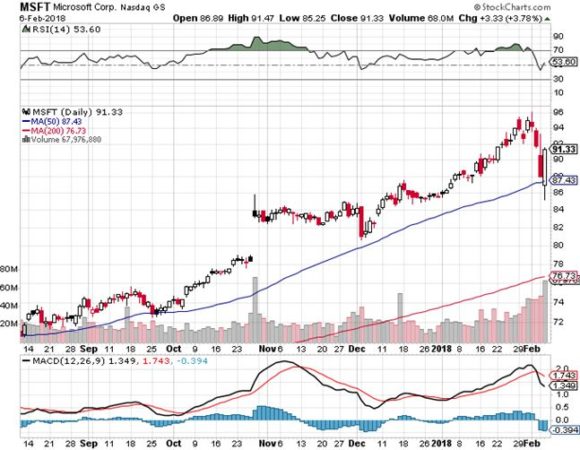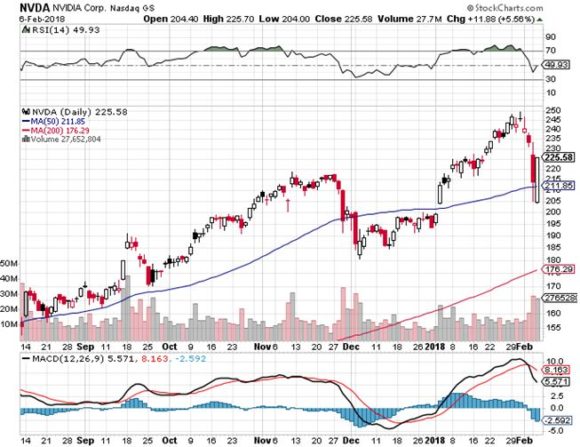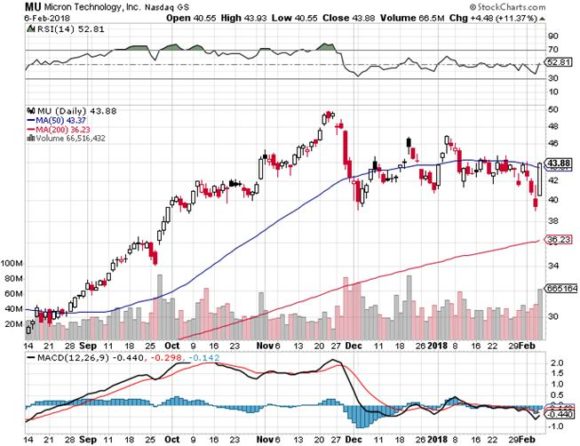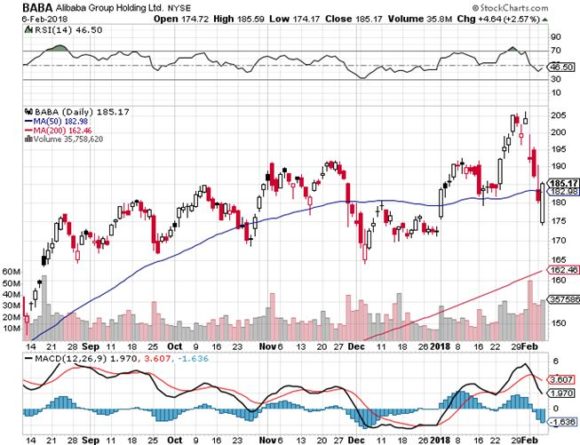When the dust settles from this sharp selloff, the bargain hunters will come out in droves. A plethora of high quality names will be available for a serious discount and the Mad Hedge Fund Trader is going to tell you exactly which tech names you should dip your toe into.
Many investors have been shut out of tech because their ascent was so rapid. Here is a chance for a second bite of the Apple.
??
Apple (AAPL)
Apple, the creators of the iPhone and IoS operating system, is hitting all the right notes despite the recent correction. Apple stock is under selling pressure due to tepid guidance.
However, iPhone unit sales are not as bad as initially thought when analyzed more closely. The underlying growth drivers are still intact, and management will explain details about how they will allocate their cash hoard in the spring.
The stock valuation is mouthwatering and just dropped from 15.7X forward PE to the current 13.74X in a matter of 10 trading days. For investors who can withstand the short-term whipsawing, the recent pullback in Apple looks like a godsend long term.
??
Amazon (AMZN)
The unrelenting land grab continues for this stock and the health industry is the latest potential victim.
This predator is blowing past any guidance put forth and analysts estimates are repeatedly blown out of the water. Carrying the load is their cloud play, Amazon Web Services, which finances its e-commerce division to full effect.
This is why they can afford operating at such low margins and offer prime subscribers free two-day shipping. Amazon's cloud unit is the rapidly expanding and most profitable business of the company.
For the quarter, AWS sales jumped 45% YOY, while generating $1.3 billion in operating income, a whopping 64% share of Amazon's total operating income.
The AWS revenue came in at??$5.11 billion vs. $4.97 billion, and Amazon's CFO Brian Olsavsky detailed record order volume and improved warehouse efficiency during the busy holiday shopping season for the recent winter.
In the last few days, some analysts have raised their price targets to $1800 and cannot keep pace with the parabolic price action.
??
Alphabet (GOOGL)
Digital advertising is a two horse race these days, with Google (GOOGL) and Facebook (FB) controlling between 60-70% of the total digital ad market share.
The total market revenue of global digital advertising and total media advertising are shaping out to be like a hockey stick. This should spur major revenue growth on just advertising alone.
Advertisers are demanding more granularity in hyper- targeting capabilities to reach specific desired consumers. Google and Facebook have smartly positioned themselves at the front of this demand curve by being the ad publishers with some of the best-of-breed targeting abilities in the digital ad space.
Facebook is able to provide targeting based upon consumer interests and Google executing based on the data provided by user searches and this twin behemoth have an insurmountable lead among digital ad publishers.
Facebook (FB)
This stock is a great buy and shares many of the same synergies with Google. Duopolies are very positive for shareholders, meaning very little digital ad revenue are not taken in by these two tech giants.
Cornering an industry is a tough objective to meet, but decades of perfecting and beefing up their ad developer technology is showing up vividly on the earnings reports.
There simply is nowhere else to go if you want to advertise on a mobile, digital platform and expose yourself to a great number of high quality customers.
Advertisers do not have any other choice except Google, which is on this list to no surprise. Facebook approximately tracks users to 80% of habitually used websites by operating tracking tools that activate if you are still logged in to the social media platform. They can literally see and jot down your every digital move.
??
Netflix (NFLX)
An Amazon-esque stock that shrugs off earnings for new subscriber growth. Who cares if they have negative cash flow if they are growing their subscribers at a insanely fast clip?
The only metric investors are interested in is total new subscriber growth, and the street had expected a not too shabby 6.39 million. Netflix easily eclipsed this total by adding 8.33 million.
Netflix has an uncannily low attrition rate due to the high premium content it offers customers creating an optimal customer experience. Netflix is really going pedal to the medal by investing over $8 billion in original content this year.
This is a stark difference from their previous business model by investing in non-original programming produced by other companies like Disney. Disney finally woke up to the erosion and swiftly purchased 21st Century Fox last year and plans to launch its own Netflix imitation shortly.
If Netflix persists to deliver fantastic content and I am confident they will then this growth story will remain intact for shareholders.
??
Alibaba (BABA)
The Chinese online sales platform is a proxy for the health of the Chinese economy and particularly the Chinese consumer.
The sales segment surged 57% higher in its core commerce division. This division accounted for 88% of Alibaba's total third-quarter revenues.
Though far smaller, the cloud computing division more than doubled its sales to $553 million. Alibaba's management plans to invest large chunks of the quarter's $7.1 billion in free cash flows into accelerating this vital business even further.
The company reached 580 million monthly active users in December, a 17% year-over-year gain. Annual active subscribers for calendar year 2017 landed at an amazing 515 million, a 16% increase from 2016's levels.
The expansion of smartphone and ubiquitous high-speed internet penetration has helped drive revenues in the core commerce business across China. They also agreed buy a 33% stake in valuable??Ant Financial Services Group, formerly known as Alipay. Ant Financial is the most valuable fintech company in the world and its 3rd party payment processor is the most popular method of payment in greater China.
The relationship started back in 2014 and unremarkably most goods bought on Taobao and T-Mall, Alibaba???s digital sales platform, are paid with Ant Financials payment technology.
In the cloud segment Alibaba leads all Chinese companies and is comparable to the Amazon???s AWS in America. Trailing distantly, but growing rapidly, was Alibaba, whose cloud??earned $553 million??in revenue in the last quarter, representing a 104% YOY jump, yet they still lag behind Amazon, Microsoft, IBM, and Google in the cloud wars.
The stock was in dire need of a healthy pull back and the selloff was exactly what the doctor ordered after Alibaba made a parabolic move in January from $172 to $205.
This is no doubt at least a $200 stock and investors will be vindicated for buying the dip.
??
Salesforce (CRM)
Salesforce provides enterprise software, delivered through the cloud and is present in many Fortune 500 companies.??
This Customer Relationship Management (CRM) platform is the modern way to amalgamate staff???s resources and give them tools to work together, even if different branch offices dot both hemispheres.
The Company focuses on cloud, mobile, tablet, Internet of Things (IoT) and artificial intelligence technologies.
The Company???s service offerings are configured and integrated with other platforms and enterprise applications and really is the best of show in this space.
Marc Benioff leads this brigade and audaciously set a mammoth target of $20 billion in revenue by FY2022. I am the last person that would bet against this.
Micron (MU)
The DRAM and NAND chip company from which companies beg to get sufficient amount of chips to power their smartphones, homepods, AI related products, IoT devices, and autonomous cars.
These products are simply pieces of junks without these (MU)???s chips. From 2017, numerous semiconductor chips CEO???s have chimed in with declaring the pricing environment as ???firm???.No surprise that Apple is charging $1000 for smartphones now, as pricey chip inputs erode more of their margins which are passed on to the consumer.
DRAM and NAND chip demand see no signs of slowing, as the exponential growth in data require more of these chips per device to be adequately functional. DRAM and NAND chip players should be the heart of any tech portfolio investors assemble.
??
Nvidia (NVDA)
The GPU (Graphics Processing Unit) is the core driver for Nvidia. The fundamental levers for this company are Artificial Intelligence (AI), self-driving cars, cryptocurrency, and eSports. All of these drivers hugely depend upon Graphic Processing Units (GPUs) and Nvidia is one of the main manufacturers of GPUs.
Every segment of their business is ascending, and their CEO, Jensen Huang, is a genius. When all these brand spanking new technologies hit the mass market, exponential growth in demand for GPU???s will be a certainty. The problem until today is finding any sort of entry point into this stock. Now you finally have one!
Microsoft (MSFT)
This is not your father???s Microsoft.
The revamped version of this company has a fresh business model based on the cloud. A few years ago (MSFT) was headed for the graveyard with its stale legacy business of Bill Gates???s era percolating around their Seattle offices.
However, what a comeback with Microsoft Azure; Microsoft???s enterprise cloud software offering a mix of solutions for companies and is the number two cloud platform behind Amazon.
Microsoft Azure is also growing faster that Amazon with 98% growth YOY, this is double Amazon???s AWS growth. They are truly a force to be reckoned with and are a legitimate option for companies looking for a hybrid medley of enterprise cloud software.
The product performance has fostered rave reviews around the business community. The demand for cloud solutions will explode in the coming years with every mom and pop shop and up looking to move their operations onto these platforms.
The recently upward price action is a direct result of the cloud segment catching up with Amazon and providing a legitimate alternative.






